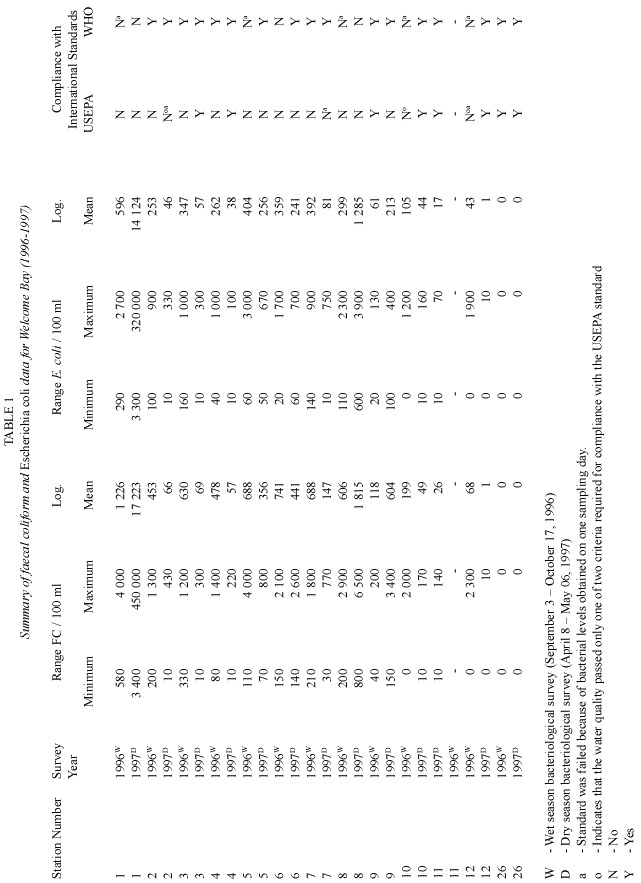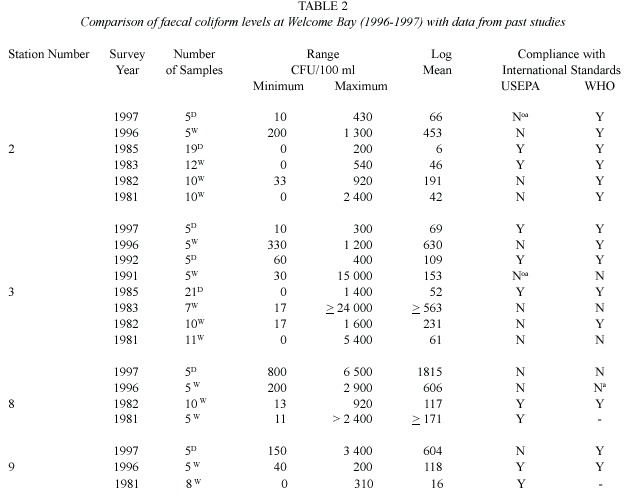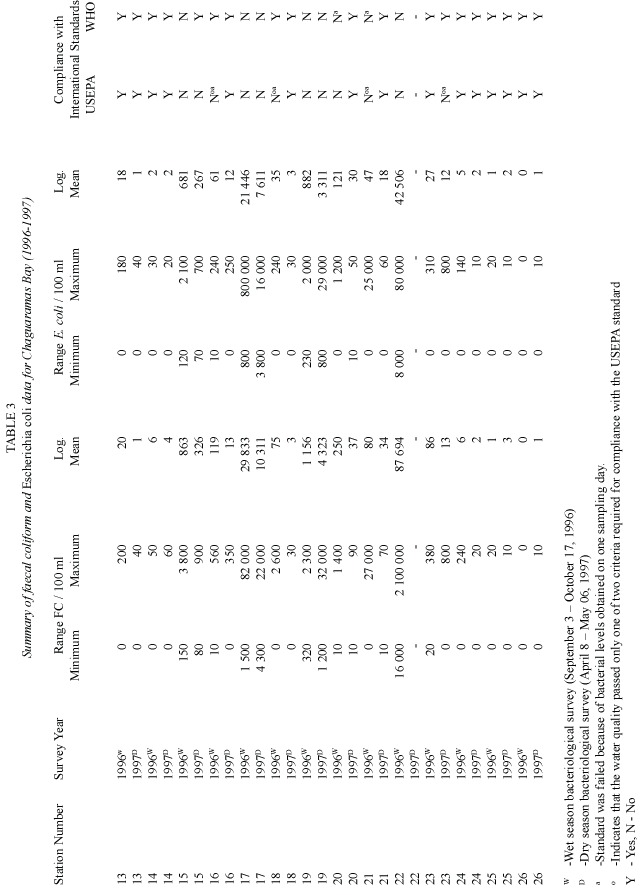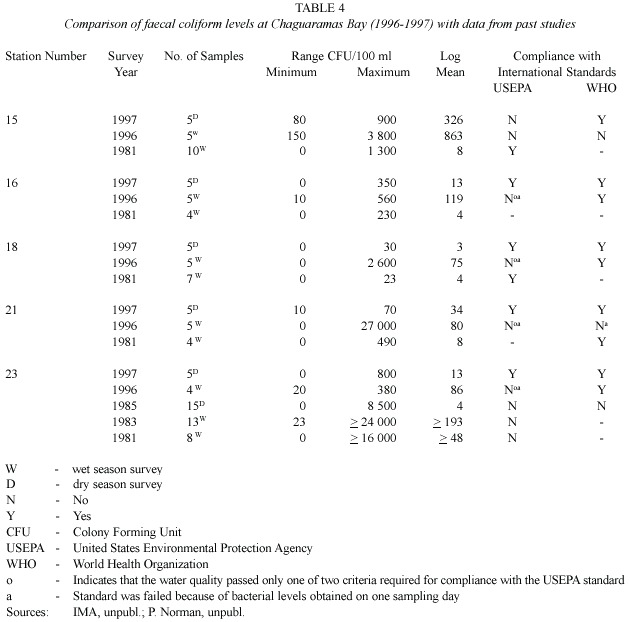Services on Demand
Journal
Article
Indicators
-
 Cited by SciELO
Cited by SciELO -
 Access statistics
Access statistics
Related links
-
 Similars in
SciELO
Similars in
SciELO  uBio
uBio
Share
Revista de Biología Tropical
On-line version ISSN 0034-7744Print version ISSN 0034-7744
Rev. biol. trop vol.53 suppl.1 San José May. 2005
Potential sources of bacteriological pollution for two bays with marinas in Trinidad
Christine Ann Bullock &Indar Moonesar
Institute of Marine Affairs,Hilltop Lane Chaguaramas,P.O.Box 3160,Carenage Post Office Trinidad and Tobago,West Indies.Fax:868 634 4433;cbullock@ima.gov.tt,mctech@ima.gov.tt
Received 15-I-2003. Corrected 19-XI-2003. Accepted 29-III-2004.
Abstract: Welcome Bay and Chaguaramas Bay in the northwest peninsula of Trinidad contain large marinas and smaller sections of bathing beaches.Bacteriological surveys were conducted at both bays to assess water quality and to determine potential sources of pollution.These surveys were conducted during the wet season of 1996 and the dry season of 1997.Eleven sample stations were established at Welcome Bay and 12 at Chaguaramas Bay.Freshwater samples were collected from rivers and drains within the survey area.Marine water samples were collected from marinas,bathing beaches and inshore and outer areas at both bays.Five water samples were collected from each sampling station during the wet season of 1996 and six during the dry season of 1997.The membrane filter technique was used to determine faecal coliform and Escherichia coli levels in all samples. There was a seasonal effect on water quality,with significantly higher faecal coliform levels in the wet season, when water quality was not in compliance with international standards.This represents a potential health risk in bathing areas.Water quality was better at the outer area of both bays.Water quality at the inner bay areas was most likely adversely affected by land-based sources of pollution identified in this study.These sources include three drains and two rivers,which discharged into the bays.Yachts were apparently not a source of sewage pollution:there was no significant relationship between yacht number and faecal coliform levels.
Key words:Bacteriological water quality,land-based sources,seasonal effect,Trinidad,Welcome Bay, Chaguaramas Bay.
Welcome Bay and Chaguaramas Bay are located in the northwest peninsula of Trinidad. At Welcome Bay there is a small public bathing area,a marina that occupies much of this bay with about 116 yacht moorings,a night-club/restaurant facility on the waterfront and a Coast Guard facility.Bacteriological water quality surveys conducted at Welcome Bay in the early 1980 s found that the bathing area was contaminated with sewage (IMA,unpublished, P.Norman,unpubl.).The main sources of pollution for this bay were identified as a broken underwater sewerage line,by-pass valves on the central sewerage system which discharged raw sewage close to shore,and a pump house in the central sewerage system without automatic level switches,which often resulted in an overflow of raw sewage to the near shore waters of the bay.By 1985 these problems had been addressed and bathing water quality at Welcome Bay was in compliance with international standards (P.Norman,unpubl.).
At Chaguaramas Bay there are industrial activities along the shoreline.This area is the primary location for the major haul-out yards, mooring and marina facilities in Trinidad. There are also small hotels,shipbuilding and dry-docking facilities and a small man-made bathing beach.Water quality studies conducted in 1981 and in 1983 found evidence of sewage contamination at the man-made beach (IMA,unpubl.,P.Norman,unpubl.).Discharge from a broken sewerage line on land was contaminating the near shore waters of the beach via an underground drainage system.Kitchen wastewater also flowed directly into the near shore waters of the beach from a hotel located there.By 1985 the broken sewerage line had been repaired,but there was still contamination at the beach due to overflow from a sewage pumping station in this area (P.Norman, unpubl.).Subsequent to the water quality studies conducted in the early 1980 s,there was a steady increase in yachting activities at both bays,and industrial activities at Chaguaramas Bay.
The present study was undertaken in 1996/1997 to determine whether increased activities at both bays had any impact on water quality.The objectives of this study were to assess bacteriological water quality at Welcome Bay and at Chaguaramas Bay,to identify factors influencing water quality at both bays and to determine whether there was any deterioration in water quality at both bays by comparing data obtained in this study with that from previous studies.
Material and methods
Location of sampling stations
The location of sampling stations at Welcome Bay and at Chaguaramas Bay were based on the following factors:the location of sampling stations in previous bacteriological studies,so that data from this study and data from past studies could be compared;the presence of effluent outfall lines in the study area; the location of drains which discharged into the study area;and the use of the area for bathing purposes (Fig.1).
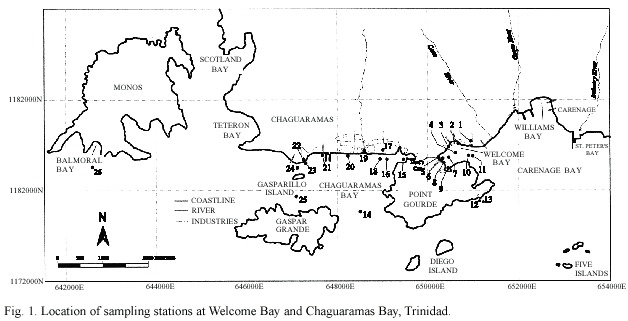
During the study period,11 sampling stations were established at Welcome Bay and 12 at Chaguaramas Bay.The survey area was located between 10 º40 03 "and 10 º40 88 "N and 61 º37 04 "and 61 º41 78 "W.At Welcome Bay, Stations 1 and 5 were located at drains,which represented possible land-based sources of pollution.Stations 2 and 3 were at bathing beaches.Stations 6,8 and 9 were along the inner bay area and Stations 10 and 11 were located at the entrances to Welcome Bay.Stations 4 and 7 were at yacht mooring sites.
At Chaguaramas Bay,Station 15 was located at a marina in a small-enclosed section,at the eastern end of the bay.This marina has slips with a maximum capacity of 72 vessels.Stations 16, 18 and 20 were at yacht mooring sites.Station 21 was in the vicinity of an offshore effluent outfall line.Stations 17 and 19 were located at rivers,while Station 22 was established at a drain. These three stations represented possible land-based sources of pollution for Chaguaramas Bay.Station 23 was approximately 30 m west of the man-made beach at this bay.Stations 14, 24 and 25 were located at the three entrances to Chaguaramas Bay.
During this study,two stations (12 and 13)were established at the bay area off Point Gourde,where there is an offshore effluent outfall line (P.Norman,unpubl.).Point Gourde lies between Welcome Bay and Chaguaramas Bay and is the location of a sewage treatment plant.Sewage from the mainland areas east of Point Gourde is piped to this treatment plant via a sewage line,which runs across the seafloor at the entrance to Welcome Bay (P. Norman,unpubl.).A control station (St.26) was included in this study.This station was located at a pristine area,approximately 1.6 km south of Balmoral Bay at Monos Island.
Sample Collection
Five water samples were collected from each sampling station during the wet season of 1996 and six during the dry season of 1997. This was in compliance with the sampling protocol of the United States Environmental Protection Agency (USEPA)standard for bathing beaches (USEPA 1976).Samples were collected between 20 cm to 25 cm below the surface of the water in sterilized glass bottles. The water samples were transported on ice,in a thermo-insulated container,to the laboratory at the IMA and were analyzed within six hours of collection.
Bacteriological Analyses
The membrane filter technique was used to determine indicator bacteria levels in all samples.For the isolation of faecal coliforms, m TEC medium was used,and levels of Escherichia coli were determined by transferring the filters from the m TEC medium to pads saturated with urea substrate (Dufour et al. 1981).Urease negative colonies were considered to be Escherichia coli.Urease negative colonies were verified as E.coli by conducting oxidase and indole testing on a minimum of ten typical isolates,assessing growth of the isolates on Simmons citrate agar and by determining whether there was gas production during growth in EC broth.Colonies that were EC gas positive,indole positive,oxidase negative and did not grow in citrate medium were considered to be E.coli .
Analysis of Results
The logarithmic mean and the percentage of samples with levels greater than specified guideline levels of faecal coliforms and E. coli were calculated.The guidelines were the USEPA and the World Health Organization (WHO)standards for bathing water (USEPA 1976,WHO 1981).Pearson s correlation test was used to assess whether there was any impact on bacteriological water quality from yachting activities.This was done by determining whether there was any relationship between yacht number and faecal coliform levels at Welcome Bay and at Chaguaramas Bay.
Results
Welcome Bay
Faecal coliform levels at the two stations (2 &3)located at bathing beaches in Welcome Bay were significantly higher (ANOVA, p<0.05)during the wet season than in the dry season (Table 1,Fig.2).Water quality at the popular bathing area at station 3 was in compliance with the USEPA (1976)standard for bathing beaches in the dry season (Table 1). However,water quality at the bathing beach at station 2 failed the USEPA (1976)standard in the dry season.This was because of a high faecal coliform count of 430 colony forming units (CFU)per 100 ml of sample obtained on one of the sampling days (Table 1).Both stations 2 and 3 failed the USEPA (1976)standard in the wet season (Table 1).
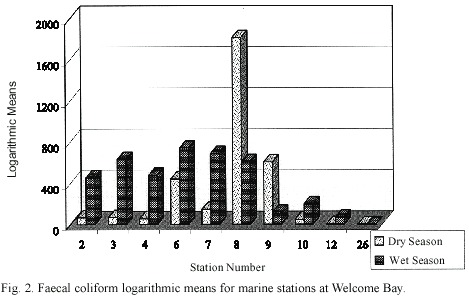
There was sewage contamination at Stations 6,8,and 9,which were located at the western section of Welcome Bay.E.coli levels of up to 3900 CFU,400 CFU and 1700 CFU per 100ml were obtained during the dry season at stations 8,9 and 6 respectively (Table 1).
Stations 4 and 7 were among yachts moored at Welcome Bay.At both stations there was a seasonal effect on water quality,with significantly higher coliform counts (ANOVA,p<0.05)being obtained in the wet season than in the dry season (Table 1).The number of yachts moored at Welcome Bay ranged from 83 to 126 in the wet season and from 122 to 167 in the dry season. There was no significant relationship (Pearson s, p>0.05)between yacht number and faecal coliform levels at Welcome Bay.Additionally,there was never any visible evidence of sewage discharge from the yachts such as floating faecal matter,during sample collection.
Stations 10 and 11 at the outer section of Welcome Bay usually had low faecal coliform levels in the dry season,up to 170 CFU and up to 140 CFU per 100 ml respectively (Table 1). However,occasional high coliform levels,up to 2000 CFU per 100 ml,were obtained at the mouth of Welcome Bay in the wet season.
Stations 1 and 5 were at drains,which flowed directly into Welcome Bay.In the dry season,higher levels of faecal indicator bacteria were found at station 1,than in the wet season.Faecal coliform and E.coli counts were as high as 450 000 CFU and 320 000 CFU per 100 ml respectively at station 1 in the dry season (Table 1).Such high faecal bacteria counts indicated the presence of sewage contamination. Coliform levels at station 5 were significantly higher (ANOVA,p <0.05)in the wet season than in the dry season.
Bacteriological water quality at stations 1 and 5 were compared with USEPA (1976)and WHO (1981)international standards for bathing beaches.Although both stations were never used for recreational water activities,the flow from these stations possibly could influence water quality at other sections of Welcome Bay used for bathing purposes.In the dry season and wet season,water quality at station 1 failed both the USEPA (1976)and WHO (1981)standards for bathing beaches (Table 1).At station 5,the water quality failed both the USEPA (1976)and WHO (1981)standards in the wet season. Both stations 1 and 5 were therefore land-based sources of sewage pollution for Welcome Bay.
Faecal coliform data from past studies conducted at Welcome Bay were available for Stations 2,3,8,and 9 (Table 2).A comparison of data from the present and past studies indicated that in the dry season,water quality at Welcome Bay,which was assessed using the USEPA (1976)and WHO (1981)standards, was as good as in past years.In the wet season however,water quality had deteriorated over the years.
Chaguaramas Bay
There was seasonal variation in water quality at stations 15,16,18 and 20,which were located among yachts moored at Chaguaramas Bay (Fig.3)Variance analysis of the data indicated that faecal coliform levels at these stations were significantly higher (ANOVA, p<0.05)in the wet season,than in the dry season.Station 15 generally had the highest coliform counts among the inner bay stations (Table 3).The number of yachts moored at Chaguaramas Bay ranged from 21 to 90 in the wet season and from 32 to 113 in the dry season.As in Welcome Bay,there was no significant relationship (Pearson s,p>0.05)between yacht number and faecal coliform levels at Chaguaramas Bay.
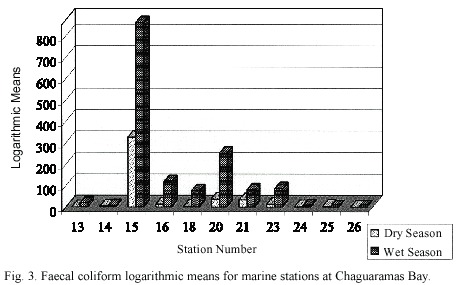
Coliform levels were usually low at station 21,which was in the vicinity of a dry docking facility.On one sample day however,there was an E.coli count of 25 000 CFU per 100 ml of sample (Table 3).This station was located at the section of Chaguaramas Bay,where there was an offshore effluent outfall line.
Generally all of the inshore stations at Chaguaramas Bay had higher bacteria levels in the wet season than in the dry season (Table 2). Stations 14,24 and 25 were at the outer area of Chaguaramas Bay and water quality was generally good over the study period,with low coliform levels at all these stations (Table 3).
High E.coli levels at station 17 of up to 80 000 CFU per 100 ml over the study period, and at station 19 of up to 29 000 CFU per 100 ml in the dry season,indicated that there was sewage contamination at both stations (Table 3).These stations were located at rivers,which represented possible land-based sources of bacteriological pollution for Chaguaramas Bay during the study period.
Station 22 was located at a drain that emptied into the near shore waters of Chaguaramas Bay.During the dry season,this drain was usually dry and hence could not be sampled. Very high E.coli levels of up to 800 000 CFU per 100 ml in the wet season indicated the presence of sewage contamination. There is a popular man-made beach east of this drain and increased flow from this drain during the wet season would affect bathing water quality at this beach.Water quality at station 22 in the wet season was compared with the USEPA (1976)and WHO (1981)standards for bathing beaches.Water quality here failed both of these international standards (Table 3).Station 22 therefore represented another land-based source of sewage pollution for Chaguaramas Bay.
A sewage treatment plant for one of the central sewerage systems in the Chaguaramas area is located at Point Gourde. Chaguaramas and Welcome Bays are located to the west and east of Point Gourde.The currents within the passage between Cronstadt and Carerra Islands and Point Gourde can attain speeds of up to 50 cm s-1 ,with rising tide current directions to the east and falling to the west (N.Gopaul and F.Teelucksingh,unpubl.).Any poor quality effluent discharged here would adversely affect water quality at both Chaguaramas and Welcome Bays.Over the study period,there was no evidence of sewage contamination at stations 12 and 13 located at Point Gourde,but there was a seasonal effect on water quality. Higher coliform levels were obtained at stations 12 and 13 in wet season,than in the dry season (Tables 1and 3).Water quality at Point Gourde would therefore not have affected water quality at either Welcome Bay or Chaguaramas Bay during this study.
A control station (26)located off Monos Island provided background bacteriological water quality data for this study.Over the entire study period,very low faecal coliform levels ranging from 0 to 10 CFU per 100 ml were obtained here.Of all stations sampled at Welcome and Chaguaramas Bay,only those located at the entrances to both bays had faecal coliform levels in the dry season,which were not considerably higher than levels obtained at the control station.
Faecal coliform data from past studies conducted at Chaguaramas Bay were available for stations 15,16,18,21 and 23 (Table 4).Past dry season data was only available for station 23.Water quality at this station,which was assessed using the USEPA (1976)and WHO (1981)bathing beach standards, was better in this study than in the previous study.In the wet season however,water quality deteriorated over the years.
Discussion
This study identified several land-based sources of pollution for Welcome Bay and Chaguaramas Bay.One of the two drains tested,which discharged into Welcome Bay, was found to be sewage contaminated.The most likely source of contamination here was a malfunctioning pump house in the central sewerage system serving this area.When this pump house malfunctions,raw sewage flows into station 1.This pump house was also identified as a source of sewage contamination for station 1 in studies conducted by the IMA between 1981 and 1984 (P.Norman,unpubl.).At that time this problem was addressed by putting the pump on automatic operation and by the installation of floats and switches.
Similarly,another malfunctioning pump house facility servicing the central sewerage system in the Chaguaramas area was the most likely source of sewage contamination for a drain,which was identified as a land based source of pollution for Chaguaramas Bay. Whenever this pump house malfunctioned,raw sewage flowed into this drain.Two sewage-contaminated rivers were also identified as land based sources of pollution for Chaguaramas Bay.It is suggested that wastewater and seepage of sewage from septic tanks at compounds near the rivers were sources of contamination for these rivers.
The presence of land based sources of pollution for Welcome Bay and Chaguaramas Bay was also indicated by differences observed in water quality between the inshore area and the outer section of both bays.During the dry season survey at Welcome Bay,the inner bay area had poor water quality while the outer section of this bay usually had low faecal coliform levels.Similarly,at Chaguaramas Bay there was occasionally poor water quality at the inshore area in the wet season,while water quality at the outer area of Chaguaramas Bay was generally good,with low coliform levels over the study period.The better water quality found at the outer bay area of Welcome Bay and Chaguaramas Bay indicated that the sources of pollution for each bay were in the vicinity of the inner bay area.
It was indicated previously that water quality at the outer area of Chaguaramas Bay was generally good over the study period. Chaguaramas Bay is characterized by high current speeds (N.Gopaul and F.Teelucksingh, unpubl.).The mean currents,which are important for flushing this bay,are relatively strong, 6 cm s-1 to the southeast and the outer bay areas are well flushed by the currents.This would also have contributed towards the good water quality found at the outer bay stations.
There was a seasonal effect on water quality at Welcome Bay and at Chaguaramas Bay. Rainfall data for Welcome Bay over the study period showed that total rainfall during the wet season survey (282.9 mm)was much higher than in the dry season survey (32.7 mm)(Water Resources Agency, unpubl.).Higher rainfall levels in the wet season would have resulted in increased surface runoff,storm water flow and increased flow from the sewage contaminated rivers and drains identified in this study,into the survey area.This greater water flow into the survey area possibly would have resulted in the higher faecal coliform levels obtained occasionally at the outer bay area of Welcome Bay,as well as at the bathing beaches and at the area where yachts were moored at both Welcome Bay and Chaguaramas Bay.A similar effect of rainfall levels on beach water quality was also noted by Krogh and Robinson (1996). They found that among environmental variables, rainfall had the single most important effect on faecal coliform densities at Sydney beaches.Whether this was due to increased storm water runoff at the beaches,increased discharge through outfalls,or a combination of both was unclear and was likely to depend on the individual beach being considered (Krogh and Robinson 1996).
Field observations recorded at one of the bathing beaches at Welcome Bay in the wet season supports this seasonal effect on water quality.Water quality at the beach was tested where flow from a pipe,which carried storm water from the hills,entered the near shore waters of the beach.Water was observed flowing from this pipe into the beach area on the wet season sampling day,when the highest faecal coliform level of 1300 CFU per 100 ml of sample was obtained at this section of the beach.
The seasonal effect on water quality was also evident at Chaguaramas Bay where generally all of the inshore stations had higher bacteria levels in the wet season than in the dry season. Similarly,higher ammonia,nitrate and phosphate levels were found in the wet than in the dry season at the inshore areas at Chaguaramas Bay (L.Sudama and K.Kumarsingh,unpubl.). Using the guidelines set out by Anonymous (1990),it can be concluded that the average level of nutrients found in Chaguaramas Bay in the wet season was very high.The high bacteria and nutrient levels found at the inshore area of the bay suggested large-scale anthropogenic influence,from a combination of land run off and wastewater discharges from the facilities bordering Chaguaramas Bay.
The seasonal effect on inshore water quality at Chaguaramas Bay was most evident at Almoorings Bay,which is at the eastern section of Chaguaramas Bay.Almoorings Bay had the highest coliform counts among the inshore stations.At Almoorings Bay there are low current speeds.The flow is slow because of the pocket location and hence Almoorings Bay is poorly flushed (N.Gopaul and F. Teelucksingh,unpubl.).In the wet season of 1996,there was a high average ammonia concentration (2.28 µM)and a high level of total phosphate,as high as 1.38 µM,at Almoorings Bay (L.Sudama and K.Kumarsingh,unpubl.). The high nutrient levels found here can possibly be attributed to increased land runoff into this area in the wet season,and since little flushing occurs here,this tends to lead to a build up of bacteria and nutrients.
There was sewage contamination at the western section of Welcome Bay.In addition to the high E.coli bacteria levels found at this section of Welcome Bay,there was also a high total phosphate level of 1.41 µM,high nitrate (0.71 µM)and nitrite (14.37 µM)concentrations and levels of ammonia higher than that recommended by the USEPA Ambient Water Quality Criteria for the Protection of Aquatic Life (1976)(L.Sudama and K.Kumarsingh, unpubl.).Sewage effluent is generally rich in nitrogen and phosphorus.Beers et al.(1968) indicated that levels of total phosphate above 0.83 µM might be sourced to some form of sewage contamination.The high bacteria and nutrient levels found at the western section of Welcome Bay therefore suggest that there was some source of sewage contamination for these stations.An investigation of sewage disposal practices at the compounds bordering this western section of Welcome Bay just prior to this study revealed that all sewage was usually piped to septic tanks.Wastewater from the kitchen and sinks at one compound with a restaurant/nightclub was piped to the near shore waters of Welcome Bay.This wastewater discharge and any seepage of sewage from septic tanks on compounds may have contributed towards the poor water quality found at the western section of Welcome Bay.Sewage contamination at any section of Welcome Bay is a cause for concern since this bay is characterized by slow variable currents, generally less than 15 cm s-1 resulting in poor flushing (N. Gopaul and F.Teelucksingh,unpubl.).
Field investigations were conducted prior to this study to determine whether there were any potential sources of sewage contamination for Welcome Bay from a marina located at this bay.All sewage generated at the marina was piped to a septic tank /soak away system. Wastewater from the laundry, kitchen and face basins was piped to two soak away systems.It was only runoff from the yard that entered the near shore waters of this bay.
There was sewage contamination in the vicinity of a dry docking facility at Chaguaramas Bay on one sampling day during the survey period.This section of Chaguaramas Bay was identified in a past study as the location of an offshore effluent outfall line (P.Norman, unpubl.).It is unlikely however that effluent from the outfall line would have affected water quality at this section of Chaguaramas Bay only once over the study period.A more probable source of contamination for this station during this one occasion was sewage discharged from one of the boats anchored at the nearby dock.
A comparison of data from the present and past studies indicated that water quality had deteriorated over the years in the wet season at both Welcome Bay and at Chaguaramas Bay. This was probably due to greater pollution of rivers and drains flowing to both bays with increased development along the shoreline over the years.
This study followed the USEPA (1976) and the WHO (1981)guidelines for assessment of bacteriological water quality by isolation and titer estimation of faecal coliforms and E. coli bacteria. The use of faecal coliforms as indicators of recent faecal contamination of waters was based on the assumption that faecal coliforms cannot survive for extended periods of time in the environment and that they cannot therefore become part of the normal microflora.However,several studies have shown that faecal coliforms may be part of the environmental microflora in tropical environments (Fujioka et al.1988,Rivera et al.1988).High densities of faecal coliform bacteria have been detected in pristine streams and in groundwater samples collected from many tropical parts of the world.Nucleic acid (DNA)analyses of E. coli from pristine tropical environments have indicated that they are identical to clinical isolates of E.coli (Hazen 1988).Many tropical source waters have been shown to have enteric pathogens in the complete absence of coliforms (Hazen 1988).Diffusion chamber studies with E.coli at several tropical sites found that this bacterium can survive indefinitely in most freshwaters in Puerto Rico (Hazen 1988).An evaluation of methods of enumeration of faecal coliforms indicated that currently used media have poor reliability as a result of large numbers of false positive and false negative results when applied to tropical water samples (Hazen 1988).Faecal coliform bacteria may therefore not be reliable indicators of recent faecal contamination of waters in tropical areas.Hazen (1988)suggested direct enumeration of pathogens by fluorescent staining and nucleic acid analysis and developing tropical maximum contaminant levels for certain resistant pathogens in tropical waters to enable more effective water quality assessment in the tropics.
From this study it can be concluded that land-based activities influenced inshore water quality at both Welcome and Chaguaramas Bays.These land-based sources of pollution for both bays can be controlled or eliminated by proper maintenance of the central sewage systems in the Chaguaramas area.Increased rainfall levels also adversely affected bacteriological water quality at both bays,thereby posing a health risk for bathers.Yachting activities did not significantly affect water quality at either bay.Water quality deteriorated over the years at both bays in the wet season.During this study,it was evident that there are still some unidentified sources of pollution,which need to be investigated for Welcome Bay and Chaguaramas Bay.
Acknowledgments
The authors thank the Chaguaramas Development Authority for providing a boat for the collection of water samples.Special thanks are due to Albert Cooper,whose assistance in the field was greatly appreciated. Heartfelt thanks are also due to Paul Nelson for assisting in the preparation of this manuscript and Hillary Baptiste and Lloyd Gerald for the preparation of the map of the study area.The authors also express their gratitude to Wendyann Ramrattan and Amoy Lum Kong for all the helpful comments provided during the review of this manuscript.
Resumen
Las bahías Welcome y Chaguaramas en la península noroeste de Trinidad tienen grandes marinas y secciones pequeñas de playas para bañistas.Se realizaron sondeos bacteriológicos en ambas bahías para determinar la calidad del agua y para señalar fuentes potenciales de contaminación.Estos sondeos fueron realizados durante la época lluviosa de 1996 y la seca de 1997.Once estaciones de muestreo se establecieron en Bahía Welcome y doce en Bahía Chaguaramas.Muestras de agua dulce fueron recolectadas en ríos y drenajes dentro del área de estudio.Muestras de agua de mar fueron recolectadas en las marinas,playas de bañistas,en las secciones internas y externas de las bahías.En cada estación se recolectaron cinco muestras de agua,durante la época lluviosa de 1996 y seis en la época seca de 1997.Los tipos de bacterias enumeradas fueron coliformes fecales y Escherichia coli . La técnica del filtro de membrana fue utilizada para determinar los niveles de bacterias indicadoras en todas las muestras.Se observó un efecto estacional en la calidad del agua,con niveles de bacterias más altos en la época lluviosa que en la seca en ambas bahías.En las zonas de baño los niveles eran potencialmente peligrosos para la salud pública durante la época lluviosa,cuando la calidad del agua no cumplía con las normas internacionales.Había niveles significativamente más altos de coliformes fecales en bahía Welcome y Bahía Chaguaramas en la época lluviosa que en la seca.La calidad del agua en las zonas externas de ambas bahías fue mejor que en las zonas internas.La calidad del agua en la parte interna de la bahía probablemente estaba afectada negativamente por fuentes terrestres de contaminación identificadas en este estudio.Estas fuentes incluyen tres desagües y dos ríos que descargan en las bahías.Los yates aparentemente no eran una fuente de contaminación en las bahías,ya que no había una relación significativa directa entre el número de yates y los niveles de coliformes fecales en bahía Welcome o en bahía Chaguaramas.
Key words:Calidad bacteriológica del agua,fuentes terrígenas,efecto estacional,Trinidad,Bahía Welcome,Bahía Chaguaramas.
References
Anonymous.1990.Review of potentially harmful substances.Nutrients.Reports and Studies.Group of Experts on the Scientific Aspects of Marine Environmental Protection (GESAMP).GESAMP (34).40 p. [ Links ]
Beers,J.R.,D.M.Steven &J.B.Lewis.1968.Primary productivity in the Caribbean Sea off Jamaica and the Tropical North Atlantic off Barbados.Bull.Mar. Sci.18:86-104. [ Links ]
Dufour,A.P.,E.R.Strickland &V.J.Cabelli.1981. Membrane filter method for enumerating Escherichia coli .Appl.Environ.Microbiol.14:1152-1158. [ Links ]
Fujioka,R.S.,K.Tenno &S.Kansako.1988.Naturally occurring faecal coliforms and faecal streptococci in Hawaii s freshwater streams.Tox.Assess.3:613-630. [ Links ]
Hazen,T.C.1988.Faecal coliforms as indicators on tropical waters:A review.Tox.Assess.3:461-477. [ Links ]
Krogh,M.&L.Robinson.1996.Environmental variables and their association with faecal coliform and faecal streptococci densities at thirteen Sydney beaches. Mar.Poll.Bull.33:239-248. [ Links ]
Rivera,S.C.,T.C.Hazen &G.A.Toranzos.1988.Isolation of faecal coliforms from pristine sites in a tropical rain forest.Appl.Environ.Microbiol.54:513-517. [ Links ]
United States Environmental Protection Agency (USEPA). 1976.Quality criteria for water.Report No.EAP- 440/9-76-023.Washington D.C.501 p. [ Links ]
World Health Organization (WHO).1981.Coastal water quality control in the Mediterranean.Final Report on the Joint WHO /UNEP Co-ordinated Pilot Project (MED –VII)(1976-1980).Geneva.39 p. [ Links ]













